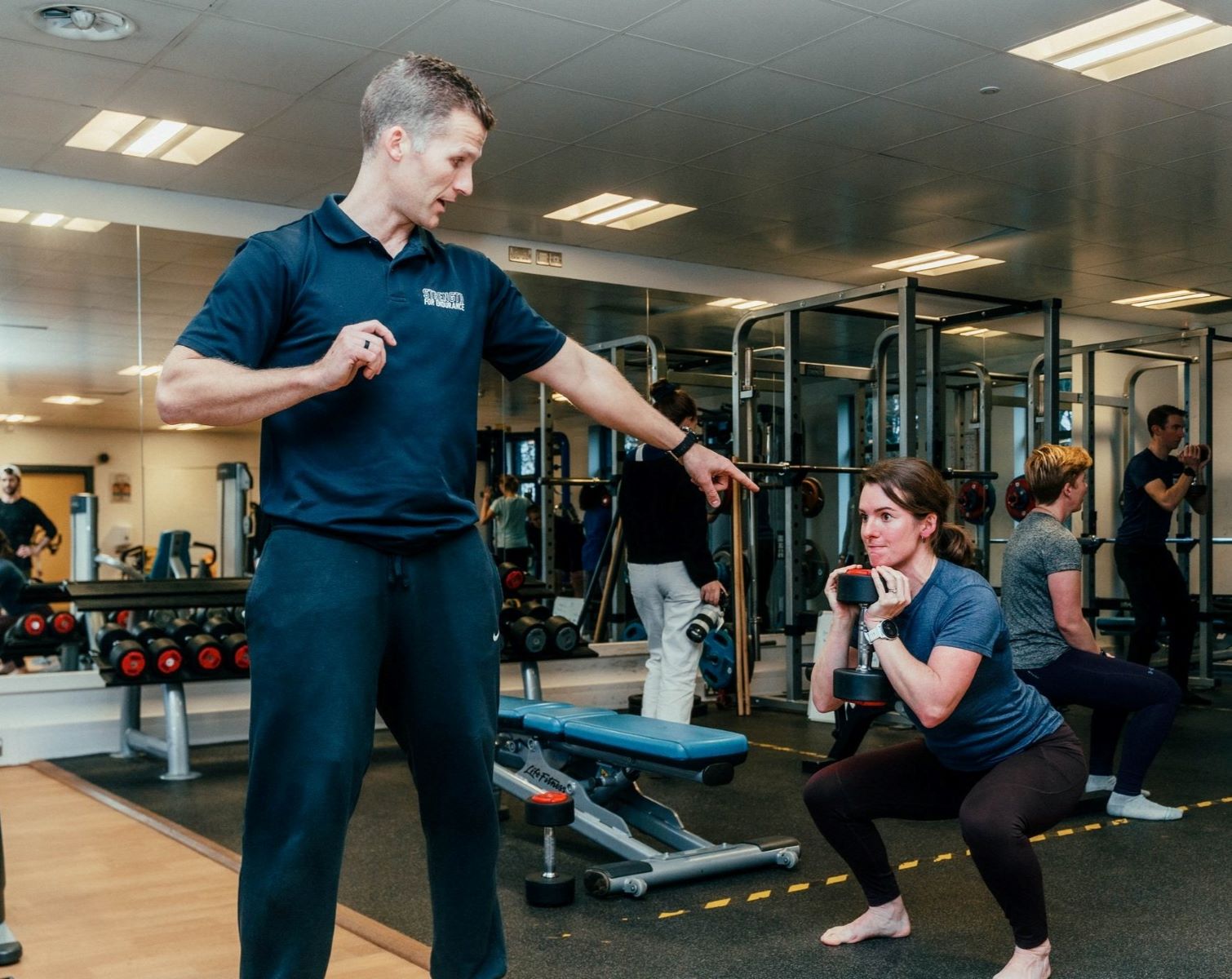Home>Misc>Featured>How Do Cardiorespiratory Fitness And Endurance Differ From Each Other?


Featured
How Do Cardiorespiratory Fitness And Endurance Differ From Each Other?
Modified: August 21, 2023
Discover the key distinctions between cardiorespiratory fitness and endurance in this insightful article. Explore how they impact your overall fitness levels and achieve your goals. Featured expert analysis and tips.
Introduction
Cardiorespiratory fitness and endurance are two key components of physical fitness that play an essential role in our overall health and well-being. While these terms are often used interchangeably, they are not exactly the same thing. Understanding the difference between cardiorespiratory fitness and endurance is crucial for those seeking to improve their fitness levels and achieve their health goals.
Cardiorespiratory fitness, also known as cardiovascular fitness or aerobic fitness, refers to the ability of the heart, lungs, and blood vessels to supply oxygen and nutrients to the muscles during prolonged exercise. It is a measure of how well your cardiovascular system functions and how efficiently it can deliver oxygen-rich blood to the working muscles.
On the other hand, endurance, also referred to as muscular endurance, is the ability of a specific muscle group or set of muscles to repeatedly exert force over an extended period. It is a measure of how well your muscles can sustain prolonged activity without fatigue.
While cardiorespiratory fitness primarily focuses on the efficiency of the cardiovascular system, endurance primarily focuses on the muscular system’s ability to perform sustained work. Both components are important for overall physical fitness, but they differ in terms of the systems they target and the types of activities they are associated with.
Improving cardiorespiratory fitness can have numerous benefits, such as reducing the risk of cardiovascular diseases, increasing energy levels, improving mental health, and enhancing overall endurance. On the other hand, improving endurance can improve sports performance, reduce the risk of muscular injuries, and increase the efficiency of daily activities.
Understanding the factors affecting cardiorespiratory fitness and endurance is key to developing effective training strategies for improvement. Assessing these components accurately can help individuals tailor their training programs to meet their specific needs and goals.
This article aims to explore the differences between cardiorespiratory fitness and endurance, delve into the factors that affect each component, highlight the benefits of improving them, and provide strategies to assess and enhance both aspects of physical fitness. By gaining a deeper understanding of these concepts, individuals can optimize their fitness regimens and achieve their desired levels of performance and well-being.
Definition of Cardiorespiratory Fitness
Cardiorespiratory fitness, also known as cardiovascular fitness or aerobic fitness, refers to the ability of the heart, lungs, and blood vessels to supply oxygen and nutrients to the muscles during prolonged exercise. It is a measure of how efficiently your cardiovascular system functions in delivering oxygen-rich blood to the working muscles.
Cardiorespiratory fitness is closely linked to the health of your heart and lungs. Regular aerobic exercise, such as running, swimming, or cycling, can help improve cardiorespiratory fitness by strengthening the heart, increasing lung capacity, and improving the efficiency of oxygen uptake and delivery.
Fitness professionals often use maximal oxygen consumption (VO2 max) as a measure of cardiorespiratory fitness. VO2 max is the maximum amount of oxygen your body can utilize during intense exercise. The higher your VO2 max, the better your cardiorespiratory fitness.
Cardiorespiratory fitness plays a critical role in overall health and well-being. It is associated with a decreased risk of chronic diseases, such as cardiovascular disease, type 2 diabetes, and certain types of cancer. People with high cardiorespiratory fitness levels often have more energy, improved mental health, and better endurance for daily activities.
Improving cardiorespiratory fitness requires consistent aerobic exercise that challenges the cardiovascular and respiratory systems. Engaging in activities such as brisk walking, jogging, swimming, or cycling for at least 150 minutes per week can lead to significant improvements in cardiorespiratory fitness over time.
It is important to note that individuals with medical conditions or those who are new to exercise should consult with a healthcare professional before starting any exercise program. They can provide guidance on appropriate intensity levels and help ensure safety during exercise.
Overall, cardiorespiratory fitness plays a vital role in maintaining good health and physical fitness. By engaging in regular aerobic exercise and improving this aspect of fitness, individuals can enjoy numerous health benefits and improve their overall quality of life.
Definition of Endurance
Endurance, also known as muscular endurance, refers to the ability of a specific muscle group or set of muscles to repeatedly exert force over an extended period. It is a measure of how well your muscles can sustain prolonged activity without fatigue.
Muscular endurance is an important component of physical fitness that is required for various activities, including sports, daily tasks, and even maintaining good posture. It is closely linked to muscle strength and overall muscular fitness.
Unlike cardiorespiratory fitness, which focuses on the efficiency of the cardiovascular system, endurance primarily focuses on the ability of your muscles to endure prolonged exertion without getting tired or fatigued.
When you have good muscular endurance, your muscles can perform repetitive or sustained activities, such as running long distances, lifting weights for multiple repetitions, or holding a plank position for an extended period.
Endurance can vary depending on the muscle group being used. For example, the endurance of leg muscles may differ from that of arm muscles. Additionally, muscular endurance can be specific to a particular activity or sport. Someone who has excellent endurance for long-distance running may not have the same level of endurance for swimming or cycling.
Improving muscular endurance involves specific training techniques that target the muscles’ ability to repeatedly contract and resist fatigue. This can be achieved through exercises such as high-repetition sets, circuit training, and isometric holds.
Engaging in regular strength training exercises, such as weightlifting or bodyweight exercises, can also improve muscular endurance. Gradually increasing the intensity and duration of the exercises can help build endurance over time.
Having good muscular endurance not only allows you to perform physical activities for longer periods but also helps prevent injuries by maintaining proper muscle balance and stability. It can also improve overall athletic performance and enhance daily functional tasks, such as carrying groceries or climbing stairs.
It is important to note that individuals should start slowly and gradually increase the intensity and duration of their training to avoid strain or injury to the muscles. Additionally, proper form and technique should be maintained during exercises to maximize the benefits of endurance training.
Having a good level of muscular endurance is beneficial for people of all fitness levels and ages. By incorporating endurance training into your fitness routine, you can enhance your overall muscular fitness and enjoy the ability to sustain physical activities for longer periods.
Differences between Cardiorespiratory Fitness and Endurance
Although cardiorespiratory fitness and endurance are both important components of physical fitness, they differ in terms of the systems they target and the types of activities they are associated with. Here are the key differences between cardiorespiratory fitness and endurance:
- Focus: Cardiorespiratory fitness primarily focuses on the efficiency of the cardiovascular system, including the heart, lungs, and blood vessels. It measures the body’s ability to deliver oxygen-rich blood to the working muscles during prolonged exercise. On the other hand, endurance focuses on the ability of specific muscle groups to repeatedly exert force over an extended period without fatigue.
- Systems Targeted: Cardiorespiratory fitness mainly targets the cardiovascular and respiratory systems. It involves activities that challenge the heart and lungs, such as running, cycling, or swimming. Endurance, on the other hand, primarily targets the muscular system. It involves activities that require sustained muscle contractions, such as resistance training or holding a static position.
- Activities Associated: Cardiorespiratory fitness is associated with aerobic activities, which require a continuous supply of oxygen for prolonged periods. These activities are typically of low to moderate intensity and can be sustained for a longer duration. Endurance, on the other hand, is associated with activities that require repetitive or sustained muscle contractions. Examples include high-repetition weightlifting, long-distance running, or performing multiple sets of bodyweight exercises.
- Measurement: Cardiorespiratory fitness is often measured using maximal oxygen consumption (VO2 max), which indicates the maximum amount of oxygen your body can utilize during intense exercise. The higher your VO2 max, the better your cardiorespiratory fitness. In contrast, endurance can be measured by the number of repetitions or the duration of sustained muscle contractions that a person can perform without fatigue.
- Impact on Health: Improving cardiorespiratory fitness has significant health benefits, including reducing the risk of cardiovascular diseases, improving mental health, and increasing energy levels. It is associated with improved endurance for day-to-day activities. On the other hand, improving endurance can enhance sports performance, reduce the risk of muscular injuries, and increase the efficiency of muscular tasks.
Understanding the differences between cardiorespiratory fitness and endurance is crucial when designing a well-rounded fitness program. By incorporating activities that target both aspects, individuals can improve their overall physical fitness, enhance their endurance, and enjoy the health benefits associated with cardiorespiratory fitness.
Factors Affecting Cardiorespiratory Fitness and Endurance
Cardiorespiratory fitness and endurance are influenced by various factors that can impact an individual’s overall physical performance. Understanding these factors is essential for designing effective training strategies and optimizing fitness outcomes. Here are the key factors that affect cardiorespiratory fitness and endurance:
- Age: Age plays a significant role in cardiorespiratory fitness and endurance. As we age, our cardiovascular system tends to decline, resulting in reduced lung capacity and decreased oxygen uptake. However, regular exercise can help slow down the decline and improve fitness levels regardless of age.
- Genetics: Genetic factors can influence an individual’s baseline cardiorespiratory fitness and endurance. Some people may naturally have a higher predisposition for aerobic capacity and endurance, while others may have a lower starting point. However, regardless of genetics, it’s important to remember that fitness levels can be improved through consistent training.
- Body Composition: Body composition, including the ratio of lean muscle mass to fat mass, can affect cardiorespiratory fitness and endurance. Higher levels of lean muscle mass generally correlate with better fitness levels and endurance, as muscles are responsible for sustained contractions during activities.
- Training Status: The training status of an individual plays a crucial role in cardiorespiratory fitness and endurance. Regular aerobic exercise and endurance training can significantly improve fitness levels. Conversely, a sedentary lifestyle or lack of regular training can lead to a decline in cardiorespiratory fitness and endurance.
- Intensity and Duration of Exercise: The intensity and duration of exercise directly impact cardiorespiratory fitness and endurance. Engaging in activities that challenge the cardiovascular and respiratory systems with moderate to high intensity and longer durations promotes greater improvements in these areas.
- Diet and Nutrition: Proper nutrition is important for supporting optimal cardiovascular health and sustainable energy levels during exercise. A balanced diet that includes a variety of nutrients, such as carbohydrates, proteins, and healthy fats, can help fuel physical activity and enhance endurance.
- Environmental Factors: Environmental factors, such as altitude and temperature, can affect cardiorespiratory fitness and endurance. Higher altitudes with reduced oxygen levels can challenge the cardiovascular system and require greater endurance. Similarly, extreme temperatures can impact performance and endurance levels.
It’s important to consider these factors when designing a training program to improve cardiorespiratory fitness and endurance. By addressing these factors and tailoring the training program to individual needs and goals, individuals can maximize their potential for improving fitness levels and achieving optimal endurance.
Benefits of Improving Cardiorespiratory Fitness and Endurance
Improving cardiorespiratory fitness and endurance offers numerous benefits for both physical and mental well-being. Regular exercise that targets these aspects of fitness can enhance overall health and performance in various areas. Here are the key benefits of improving cardiorespiratory fitness and endurance:
- Reduced Risk of Chronic Diseases: Improving cardiorespiratory fitness can significantly reduce the risk of developing chronic diseases, including cardiovascular disease, type 2 diabetes, and certain types of cancer. Regular aerobic exercise strengthens the heart, improves blood circulation, and helps maintain healthy blood pressure and cholesterol levels.
- Increased Energy Levels: Better cardiorespiratory fitness and endurance lead to improved energy levels. Regular exercise increases the oxygen-carrying capacity of the blood, enhancing the delivery of oxygen and nutrients to the muscles. This results in increased energy production and reduced feelings of fatigue.
- Enhanced Mental Health: Engaging in activities that improve cardiorespiratory fitness and endurance has significant mental health benefits. Regular exercise releases endorphins, the feel-good hormones, which help reduce stress, anxiety, and symptoms of depression. It can improve overall mood, boost self-esteem, and enhance cognitive function.
- Better Endurance for Daily Activities: Improved cardiorespiratory fitness and endurance make everyday tasks feel less challenging. Activities such as walking up stairs, carrying groceries, or performing household chores become easier and require less effort. This can enhance overall productivity and quality of life.
- Improved Sports Performance: Athletes and individuals participating in sports can benefit greatly from improved cardiorespiratory fitness and endurance. Enhanced aerobic capacity allows for better endurance, increased stamina, and improved performance in activities that require sustained effort, such as long-distance running, cycling, or team sports.
- Weight Management: Regular exercise that improves cardiorespiratory fitness and endurance contributes to weight management and potentially weight loss. Aerobic activities burn calories, helping to create a calorie deficit necessary for weight loss. Additionally, increased muscle mass from strength training can boost metabolism, leading to ongoing calorie expenditure even at rest.
- Stronger Immune System: Regular physical activity that enhances cardiorespiratory fitness and endurance can strengthen the immune system. Exercise improves the circulation of immune cells and antibodies, increasing the body’s ability to fight off infections and illnesses.
It is important to note that the benefits of improving cardiorespiratory fitness and endurance are not limited to these points. The positive impact on overall health and well-being extends beyond the physical realm to encompass mental and emotional aspects as well.
By incorporating regular exercise that targets cardiorespiratory fitness and endurance, individuals can experience these benefits and enjoy an improved quality of life.
Methods to Assess Cardiorespiratory Fitness and Endurance
Accurately assessing cardiorespiratory fitness and endurance is important for understanding an individual’s current fitness level and progress over time. Several methods can be used to assess these components of physical fitness. Here are some common methods to assess cardiorespiratory fitness and endurance:
- Maximal Oxygen Consumption (VO2 max) Testing: VO2 max testing is considered the gold standard for assessing an individual’s cardiorespiratory fitness. It involves measuring the maximum amount of oxygen that a person can utilize during intense exercise. This test is usually conducted in a controlled laboratory setting using specialized equipment, such as a treadmill or stationary bike, while monitoring heart rate and breathing.
- Submaximal Exercise Testing: Submaximal exercise tests are less intense than VO2 max testing but still provide an estimation of cardiorespiratory fitness. These tests involve exercising at a submaximal level while measuring heart rate and other relevant physiological data. The results from submaximal testing can be used to predict an individual’s VO2 max.
- Field Tests: Field tests are practical and convenient methods to assess cardiorespiratory fitness and endurance in real-world settings. These tests often involve activities such as running, cycling, or swimming and are designed to measure a person’s performance in a specific time or distance. Examples include the Cooper 12-Minute Run Test, 1-Mile Walk Test, or the Multi-Stage Fitness Test (also known as the beep test).
- Body Composition Analysis: While body composition analysis does not directly measure cardiorespiratory fitness or endurance, it can provide information about an individual’s muscle mass and overall fitness level. Methods such as bioelectrical impedance analysis (BIA) or DEXA scans can assess body fat percentage and lean muscle mass, which indirectly impact endurance and overall fitness.
- Performance Tracking: Tracking your performance and progress in endurance-related activities can also provide insights into your cardiorespiratory fitness and endurance levels. Keeping a record of distance, time, or repetitions completed, and monitoring improvements over time can help gauge progress and identify areas for improvement.
It is important to note that some of these assessment methods may require specialized equipment or the assistance of a trained professional. It is recommended to consult with a fitness expert or healthcare professional to determine which assessment method is most suitable for your specific needs and circumstances.
By regularly assessing cardiorespiratory fitness and endurance, individuals can track their progress, set realistic goals, and make informed adjustments to their training programs to optimize their fitness journey.
Training Strategies to Improve Cardiorespiratory Fitness and Endurance
Improving cardiorespiratory fitness and endurance requires a consistent and structured training approach. By incorporating specific training strategies, individuals can effectively enhance these components of physical fitness. Here are some strategies to improve cardiorespiratory fitness and endurance:
- Aerobic Exercise: Engaging in regular aerobic exercise is essential for improving cardiorespiratory fitness. Activities such as running, cycling, swimming, and brisk walking challenge the cardiovascular system and increase aerobic capacity. Aim for at least 150 minutes of moderate-intensity aerobic exercise or 75 minutes of vigorous-intensity aerobic exercise per week.
- Interval Training: Interval training involves alternating between high-intensity periods and low-intensity recovery periods. This method can be highly effective for improving cardiorespiratory fitness and endurance. Intervals can be tailored to individual fitness levels and preferences, incorporating activities like sprinting, cycling, or circuit training.
- Progressive Overload: Gradually increasing the intensity, duration, or frequency of exercise is key to improving endurance. Progressive overload challenges the body to adapt and improve by gradually pushing its limits. Start with manageable intensity and duration, then progressively increase the load over time to avoid plateaus and promote continuous improvement.
- Strength Training: Incorporating strength training exercises into your routine is beneficial for both muscular endurance and cardiorespiratory fitness. Compound exercises that engage multiple muscle groups, like squats, lunges, and push-ups, can improve both strength and endurance. Aim for two to three strength training sessions per week alongside aerobic exercise.
- Cross Training: Integrating different types of activities into your routine can help prevent boredom, reduce the risk of overuse injuries, and improve overall fitness. Engage in a variety of aerobic exercises, such as swimming, cycling, or using an elliptical machine, as well as activities like hiking or dancing to challenge your cardiovascular system in different ways.
- Consistency: Consistency is key when it comes to improving cardiorespiratory fitness and endurance. Aim to exercise regularly, ideally on most days of the week. Set aside dedicated time for workouts, and make them a priority in your schedule. Staying consistent will help build a habit and allow for steady progress.
- Recovery and Rest: Adequate rest and recovery are essential for optimizing improvements in cardiorespiratory fitness and endurance. Include rest days in your training schedule to allow your body to recover and adapt to the training stimulus. Proper sleep, hydration, and nutrition also play a crucial role in supporting recovery and maximizing performance.
Remember to start at a level that matches your current fitness level and gradually progress to more challenging workouts. It is important to listen to your body, pay attention to any signs of fatigue or discomfort, and adjust your training intensity or duration accordingly to avoid overexertion or injury.
Working with a certified fitness professional or personal trainer can provide guidance, ensure proper technique, and help design a customized training program based on your specific goals and needs.
By implementing these training strategies consistently and progressively, individuals can effectively improve their cardiorespiratory fitness and endurance, leading to enhanced performance, improved health, and a better overall quality of life.
Conclusion
Cardiorespiratory fitness and endurance are crucial components of physical fitness that play a significant role in overall health and well-being. While cardiorespiratory fitness focuses on the efficiency of the cardiovascular system, endurance primarily targets the ability of the muscles to sustain prolonged activity. Understanding the differences between these two aspects of fitness is essential for tailoring effective training programs.
Improving cardiorespiratory fitness and endurance offers a multitude of benefits. It reduces the risk of chronic diseases, increases energy levels, enhances mental health, and improves overall endurance for daily activities. Additionally, improved fitness levels can enhance sports performance, contribute to weight management, and strengthen the immune system.
Assessing cardiorespiratory fitness and endurance provides valuable information about an individual’s current fitness level and progress. Methods like VO2 max testing, submaximal exercise testing, field tests, and performance tracking can be used to evaluate fitness levels accurately.
To improve cardiorespiratory fitness and endurance, individuals can incorporate strategies such as aerobic exercise, interval training, progressive overload, strength training, cross-training, consistency, and proper recovery. Starting at a suitable level and gradually increasing the intensity and duration of workouts will yield optimal results.
In conclusion, focusing on developing both cardiorespiratory fitness and endurance is essential for improving overall physical fitness and achieving health goals. By incorporating the recommended training strategies and maintaining consistency, individuals can enhance their endurance, improve their quality of life, and enjoy the numerous benefits associated with improved cardiorespiratory fitness and endurance.









